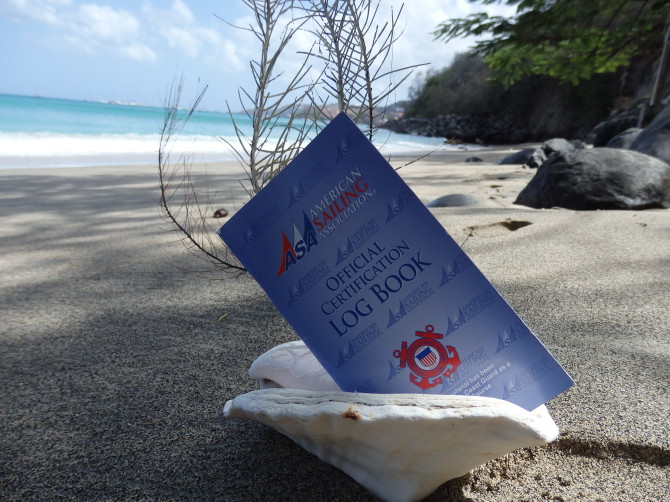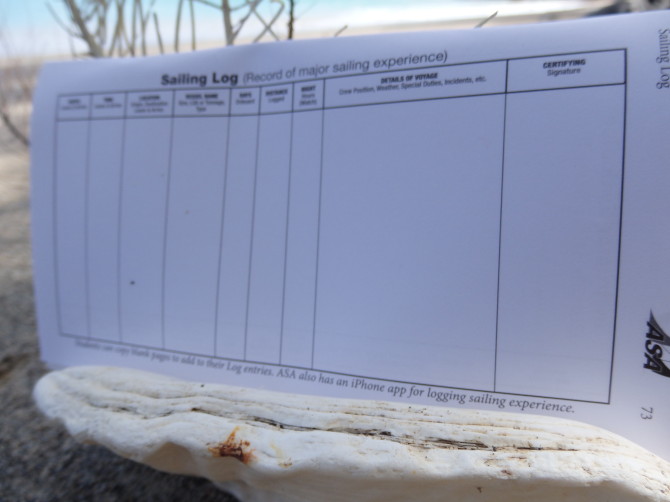Why do I need an ASA Log book?
The ASA Logbook
Captain’s Log: ASA Log Book & Documented Sailing Time
Congratulations! You’ve earned your first ASA certification and your ASA Log Book! Or maybe you have completed the Basic Cruise and Learn with LTD Sailing and you are ready to book a charter and sail on your own! One of the most important things that a charter company will ask you for is your sailing resume (That AND your credit card number!)
“Okay, so, what is that?”
Basically, it’s proof that you know how to sail a boat on your own.
“Isn’t that what my ASA certifications are for?”
YES! That tells the charter company that you have met an internationally recognized standard of skills and knowledge set forth by the American Sailing Association (ASA).
“So, why do I need anything more?”
Charter companies are looking at your certification as well as your experience on the water. Often our students will charter a boat right after their course. In that case, the charter company can get approval from the instructor to verify that the student has the skills and confidence to sail on their own. Getting out on the water is the best way to gain and KEEP those skills.
“How do I keep track of all my time on the water?”
Your instructor will give you an Official Certification ASA Log Book. In the back, you will find a Sailing Log. This is a record of your sailing experience. You might call it a brag book or a sailing diary. It records the following things:
- DATES – leave and arrive
- TIME – leave and arrive
- LOCATION – origin, and destination
- VESSEL NAME – type, size, LOA, tonnage
- DAYS ON BOARD – the number of days on the boat
- DISTANCE – logged
- NIGHT – hours, watch
- DETAILS OF VOYAGE – crew position, weather, special duties, incidents, etc.
- CERTIFYING SIGNATURE – captain or owner signature
DO NOT wait to complete this information! If you think you can just fill it in after the trip, you will regret it! It will take more time to track down the boat, get the captain’s signature or remember what the wind was like that day if you don’t do it right away! Just slip your log book into your sail bag and make it habit of filling it out during the trip.
OTHER WAYS TO LOG YOUR TRIPS:
There’s an app for that! ASA offers an iPhone app for the ASA Log Book.
If you are planning on going on to get your USCG Captain’s License, you will need 360 documented days on the water and 90 must have been within the last three years. This also requires to complete a Small Vessel Sea Service Form. Again, print some of these out, put them in a water-proof folder and stow them in your sea bag.
You can also find the captain’s logs in your local marine supply store.
The most important thing is to get out on the water as much as you can and log your trips. You will not regret keeping track of your adventures and having them handy when you are ready to take the next step in throwing off the bowlines and living the dream on the water!

The Most Important Part of the ASA System
From an academic standpoint, keeping a record of what courses have been completed is at the heart of moving forward in ASA. The official certification Logbook is the essential means to track this progress. It also contains all the standards for the various course levels and is the obligatory record of proof for certification. A Logbook must be utilized to be part of the ASA curriculum.
Does the Logbook’s Importance Go Beyond Meeting Educational Requirements?
By virtue of the American Sailing Association’s stature in the sailing world, the Logbook is also something of a sailing passport. It is a living document that not only chronicles certification connected requirements, but can be used to keep a record of any and all sea-hours accrued along the way. Having a record of all sailing-related actively, cataloged and presented in this way, acts as a recognized and respected sailing resume. For chartering, job application, or any other situation that requires proof of sailing experience, the ASA Logbook is a valuable asset recognized throughout the world.
 Becoming ASA Certified is just the beginning…
Becoming ASA Certified is just the beginning…
We give you the knowledge and experience to be confident and safe on all your sailing adventures – whether you charter a boat from a local harbor, go on an exotic sailing vacation, or even buy your own boat.
Once you have achieved certification, practice, practice, practice! How your sailing ability will be evaluated depends on many things; when, where, and to what level you become ASA certified, and how much you have sailed since your certification. However, being ASA certified will be yours for life as a testament to your ability and commitment from the day your ASA instructor signs your Logbook.
ASA Certifications
The American Sailing Association provides standards for progressive sailing certification programs, including: Keelboat Sailing, Small Boat Sailing, and Multihull Sailing. In addition, ASA provides standards for a number of endorsements, which are intended to supplement the main certification series. These include Docking, Weather, Celestial, and Radar.
Listed below are the summaries of all ASA’s Certifications. The detailed standards, including pre-requisites, for each certification may be found by clicking the title, they are also published in the ASA Official International Certification Logbook.
Each certification requires participants to fully satisfy both knowledge and skills standards, which will be verified through a written exam and an on-the-water practical exam. The standards are intended to be a minimum set of requirements. ASA affiliate sailing schools and instructors may choose to include additional requirements if they wish to emphasize knowledge or skills appropriate to local waters, conditions or practice vessels.
e or skills appropriate to local waters, conditions or practice vessels.

ASA 101, Basic Keelboat Sailing
Learn to skipper a 20′ – 27′ sloop-rigged keelboat by day, in light to moderate winds and sea conditions. Learn basic sailing terminology, parts and functions, helm commands, basic sail trim, points of sail, buoyage, seamanship and safety including basic navigation rules to avoid collisions and hazards.

ASA 103, Basic Coastal Cruising
Learn to skipper a sloop-rigged auxiliary powered 25′-35′ keelboat by day in moderate winds and sea conditions. Learn cruising sailboat terminology, basic boat systems, auxiliary engine operation, docking procedures, intermediate sail trim, navigation rules, basic coastal navigation, anchoring, weather, safety and seamanship.

ASA 104, Bareboat Cruising
Learn how to sail a sloop-rigged, auxiliary powered 30′-45′ sailboat during a multi-day cruise upon inland/coastal waters in moderate/heavy winds and sea conditions. Learn about provisioning, boat systems, auxiliary engines, advanced sail trim, coastal navigation, anchoring / mooring, docking, emergency operations, weather, and more.

ASA 105, Coastal Navigation
Learn the the navigational theory and practices for safe navigation of a sailing vessel in coastal and inland waters. On-water coastal navigation skills elements are contained in the ASA103, Basic Coastal Cruising, ASA 104, Bareboat Cruising, and ASA 106, Advanced Coastal Cruising, in progressively increasing levels of detail.




 Becoming ASA Certified is just the beginning…
Becoming ASA Certified is just the beginning…